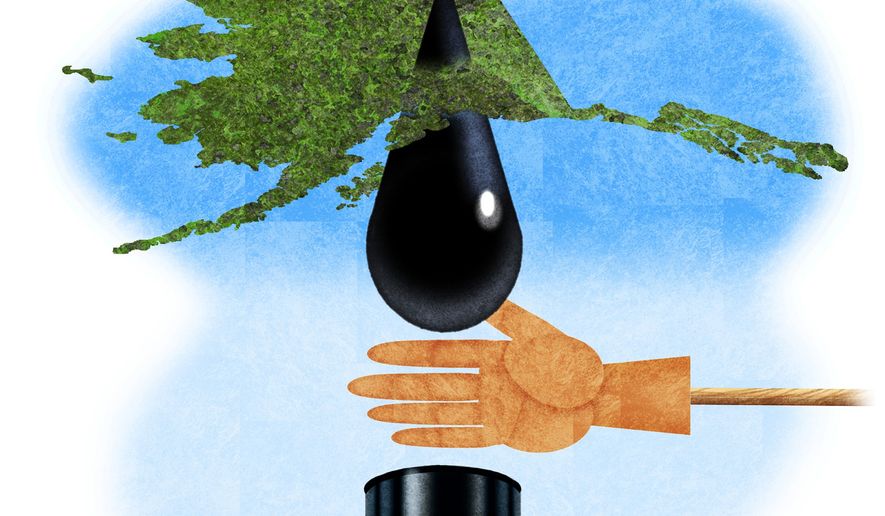OPINION:
In the northeast corner of Alaska’s National Petroleum Reserve, there’s a 600 million-barrel reserve of petroleum called the Willow project. The United States needs that oil and has had to wait too long to get it.
The lease was acquired in 1999, when Bill Clinton was president. The permitting process has continued on over two decades and through five presidential terms. Its final approval is now with the Biden administration’s Bureau of Land Management.
It has the ongoing support of Alaska’s bipartisan congressional delegation. The bureau estimates it will generate more than $10 billion in tax and royalty revenue, which, under current law, will be administered by the state of Alaska. Half the federal royalties will be used to support local native communities’ public health clinics, schools, public safety, transportation, and search and rescue capabilities.
The Willow project has the backing of native groups. This support was expressed directly to the bureau by Joe Nukapigak, president of the Kuukpik corporation. John Hopson Jr., an Inupiat whaling captain and local elected official, has called on the White House for support. Alaska Federation of Natives President Julie Kitka wrote that the project “has undergone stringent environmental permitting and a vigorous community engagement process” in a letter urging approval to President Biden’s interior secretary, Deb Haaland.
Alaska’s workers and unions are on board, too. Joey Merrick, president of the Alaska District Council of Laborers, called the project a job creator that will generate 2,000 construction jobs and 300 permanent positions. That’s a lot of jobs and paychecks in a small community. Mr. Merrick also noted the bureau’s estimate that 75% of Willow’s installation work, about 9 million man-hours, will come from union labor working for union wages.
Most of the opposition to the Willow project comes from the lower 48. The Alaska Wilderness League, which is based in Washington, D.C., and The Wilderness Society, the Sierra Club, the Defenders of Wildlife, Evergreen Action and Friends of the Earth are the groups that rallied outside the White House, calling for the termination of the $8 billion NPR-A Willow project.
Relying on the sound of their voices rather than sound science, the protesters complained about the potential impact on the environment, and the caribou and their migratory habits. They didn’t have much to say about the jobs that won’t be created if the project isn’t allowed to move forward.
In Alaska, Voice of the Arctic Inupiat, which represents Inupiat groups on the North Slope — says the protests from green groups are a threat to their way of life. “Outside groups from nearly 4,000 miles away are actively co-opting our voices and promoting misinformation to the Biden administration in an effort to drown out the perspectives of the local communities and regional leadership who overwhelmingly support the Willow Project. Those actively working to stop the Willow Project threaten our Iñupiat culture that relies on and coexists with projects like Willow.”
The greens’ loudest complaint is that the project would produce as much carbon emissions as 66 new coal-fired power plants.
Setting aside the argument that, based on demand, an equal amount of oil will be consumed, whether from Willow or Venezuela, the opposition’s carbon emissions claims are full of soot. Using EPA calculations for the latest Chinese coal-fired power plant, all the oil produced by the Willow project will produce what comes out of about eight new coal plants in a single year.
If the anti-Willow protesters were truly concerned about carbon emissions, why not picket the Chinese? In 2021, China added more coal plants than the rest of the world combined. Their emissions will wipe out several years’ worth of carbon emission reductions here in the U.S.
Perhaps carbon emissions are the real target. To compare, China produces about twice as much of the world’s carbon dioxide — 23% — as the U.S. The U.S. reduced its carbon footprint to 2005 levels by 2020. Policies remain in place to continue that trend. America leads the world in carbon dioxide emission reduction, while China is on track to double its emissions in less than 20 years.
There is a certainty that energy costs will continue to rise. This hurts Americans’ bottom line. When demand is stable and more energy is available, costs decline. When less energy is available, the price rises.
Americans cite the price of energy as one of their biggest concerns. To reduce it, produce more of it. Once online, the Willow project will help do that. Equally important, it will benefit native Alaskans, union workers and the Alaskan economy. It is time for the Biden administration to move past the protest placards and give life to Alaska’s Willow project.
• Todd Tiahrt is a former member of Congress and ranking member of the Appropriations Subcommittee on Interior, Environment and Related Agencies.




Please read our comment policy before commenting.